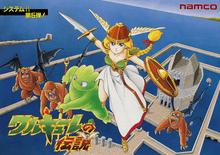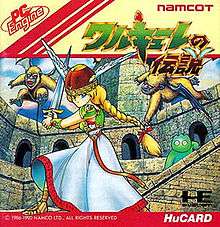Valkyrie no Densetsu
| Valkyrie no Densetsu | |
|---|---|
 Arcade flyer | |
| Developer(s) | Namco |
| Publisher(s) | Namco |
| Composer(s) | Hiroyuki Kawada |
| Platform(s) | Arcade, PC Engine, Wii (Virtual Console) |
| Release |
Arcade
Mobile Phone
PC Engine
|
| Genre(s) | Platform/Shooter |
| Mode(s) | 2 players can play simultaneously |
| Cabinet | Upright, cabaret, and cocktail |
| Arcade system | Namco System 2 |
| CPU |
2x Motorola 68000 @ 12.288 MHz, 1x Motorola M6809 @ 3.072 MHz, 1x Hitachi HD63705 @ 2.048 MHz |
| Sound |
1x Yamaha YM2151 @ 3.57958 MHz, 1x C140 @ 21.39 kHz |
| Display | Vertical orientation, Raster, 224 x 288 resolution |
Valkyrie no Densetsu (ワルキューレの伝説 Warukyūre no Densetsu, translated as: "Legend of Valkyrie") is a platform/shooter arcade game that was released by Namco in 1989 only in Japan; it runs on Namco System 2 hardware. It is a sequel to a 1986 Family Computer title titled Valkyrie no Bōken: Toki no Kagi Densetsu, also released exclusively in Japan. A port was released for the PC Engine in 1990. In 1996, the game was translated into English and released as part of the Namco Museum Volume 5 compilation on PlayStation as Legend of the Valkyrie[2] (Phozon, Genpei Tōma Den and Ordyne had also been given this treatment) - and a mobile version was released in July 2005. The PC Engine version was also ported to the Wii's Virtual Console on April 1, 2008; it was followed up by the arcade version on December 8, 2009.
Gameplay
The first player controls the eponymous Valkyrie who is not an actual Valkyrie from Norse mythology, but a warrior maiden from the heavens who happens to be named after them, while the second player controls Kurino Sandra (official Namco Museum romanization; his name has also been romanized as Xandra, and was also named "Whirlo" in the English version of Xandra no Daibōken: Valkyrie to no Deai), a green lizard who, despite his name, is actually male (and his resemblance to a lizard isn't obvious). They must fight their way through eight multi-scrolling stages by firing shots from their sword (Valkyrie) and trident (Sandra) - and most of the enemies will leave gold coins or magic bubbles behind when killed, which can be exchanged for special items with Babasama (an old male sorcerer), and Zoul (a travelling salesman who shall draw Valkyrie and Sandra into his realm when they walk up to him, and his full name is also "Zouli Zurukobicchi Kozuruinen"). To answer the Nazonazo Phantom and Sphinmoth's questions on the fourth and seventh stages, a knowledge of the two Japanese syllabic writing systems (Hiragana and Katakana) is also essential; if a player does not know, they can only guess. Also, if a player wants Babasama to teach them the "Chameleon" spell on the fifth stage, they shall have to walk up to a woman in one of the previous stage's interior areas, and speak to her so that she will give them a letter - without it, they cannot give it to Babasama, and he will not teach them the spell as a result. The clock tower at the end of the first stage also looks like a miniature Big Ben.
PC Engine differences

The PC Engine version of the game sports a big number of differences that almost make it a new game; the stage design has been changed, new stages have been added, the players are given passwords to save their progress, there is a new extra boss battle before the players fight the last boss (Kamuzu), and the ending is completely different from that of the arcade version (however, like many other Namco PC Engine conversions, the graphics and sound are inferior to that of the arcade version due to the fact that it is an 8-bit console).
Cameos
Valkyrie and Sandra make several cameos in later Namco games; the former first reappeared as a reporter in Kyūkai Dōchūki, as a match reporter, but they both later reappeared in Tinkle Pit (Sandra as a bonus character and Valkyrie as a high-score one) and in the Namco System 12-era World Stadium titles, Valkyrie on the Nikotama Gals team and Sandra on the Namco All-Stars team. Cassandra has an alternate outfit modeled after Valkyrie's in SoulCalibur II. Valkyrie makes a cameo in Super Smash Bros. for Wii U as part of Pac-Man's Taunt, "Namco Roulette". The Main Theme is part of the Namco Arcade '80s Retro Medley 2.
References
- ↑ Valkyrie no Densetsu for TurboGrafx-16 - GameFAQs
- ↑ Levy, Stuart; Semrad, Ed (January 1997). "PlayStation Expo '96-'97: Namco Steals the Show with Five New Arcade Conversions!". Electronic Gaming Monthly. No. 90. Ziff Davis. p. 110.